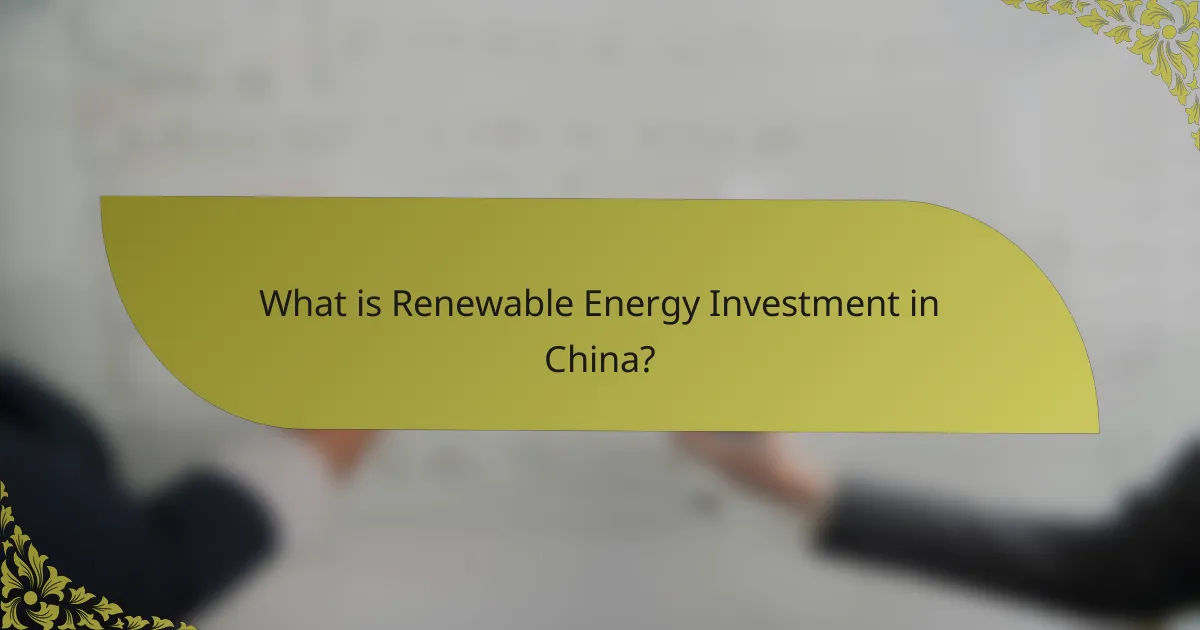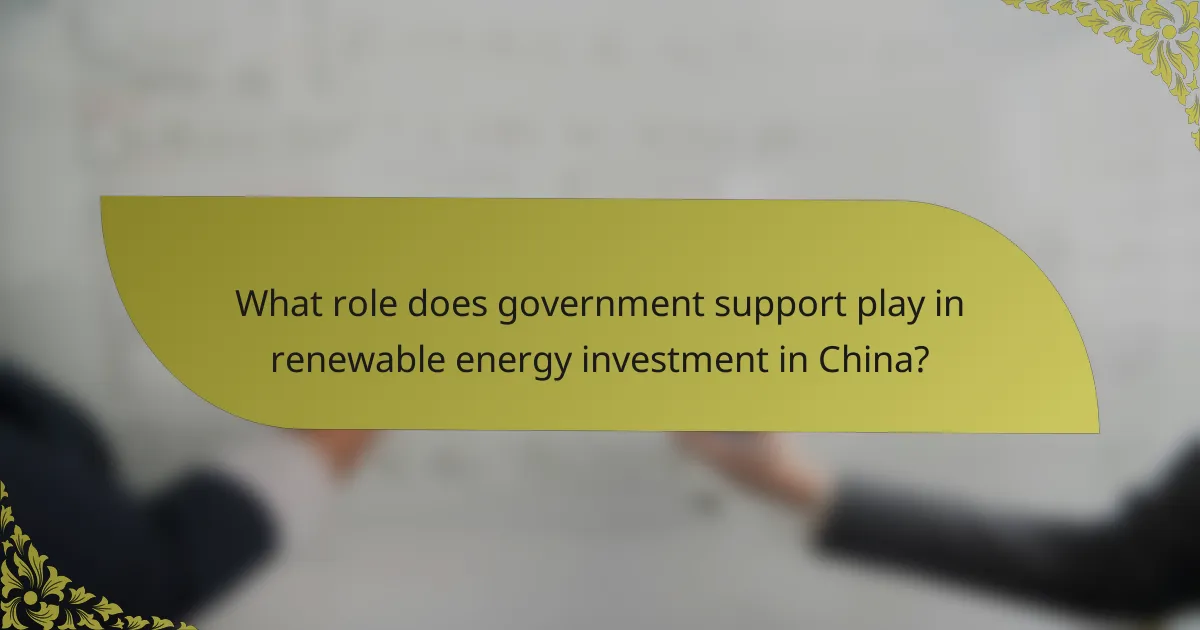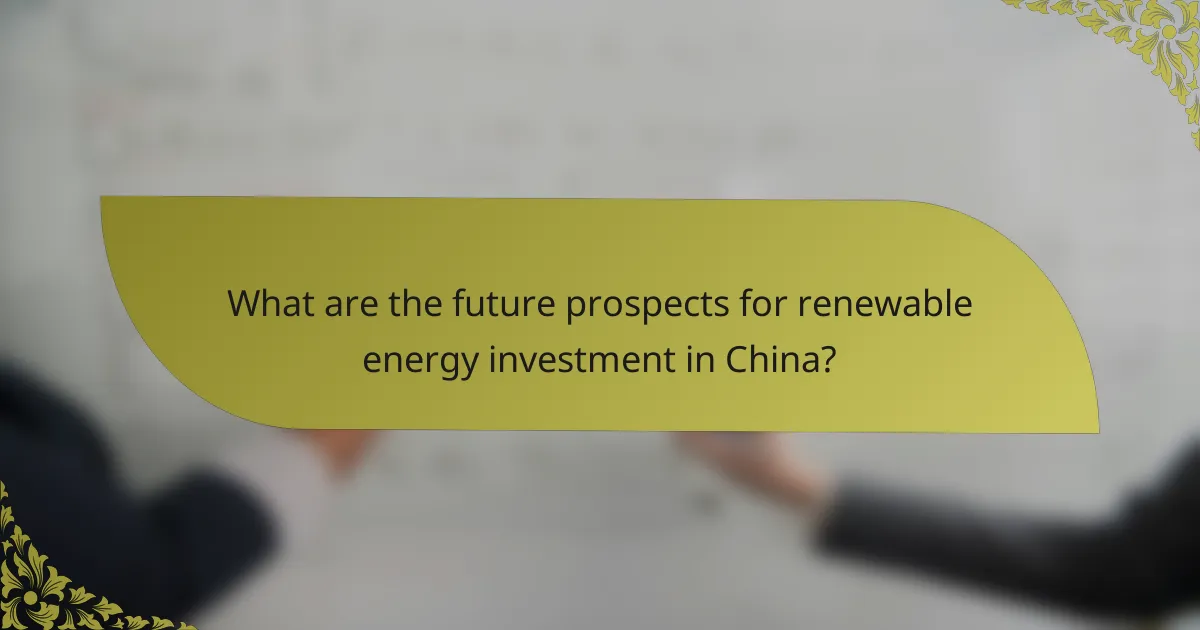Renewable energy investment in China encompasses financial commitments directed towards the development and expansion of various renewable energy sources, including solar, wind, hydroelectric, and biomass projects. China has emerged as the leading global investor in renewable energy, with approximately $83 billion invested in 2020 alone, driven by the government’s goal of achieving carbon neutrality by 2060. Government support, through financial incentives and policies such as feed-in tariffs, plays a crucial role in fostering this investment landscape. The future of renewable energy investment in China appears promising, with plans to significantly increase renewable energy capacity and a strong focus on innovation and infrastructure development.

What is Renewable Energy Investment in China?
Renewable energy investment in China refers to the financial commitments made towards developing and expanding renewable energy sources. This includes investments in solar, wind, hydroelectric, and biomass energy projects. In recent years, China has become the world’s largest investor in renewable energy. In 2020 alone, China invested approximately $83 billion in renewable energy technologies. The government’s commitment to achieving carbon neutrality by 2060 has accelerated these investments. China aims to increase its renewable energy capacity significantly, targeting 1,200 gigawatts of wind and solar power by 2030. This investment trend is supported by various government policies and incentives aimed at promoting clean energy.
How has the renewable energy sector evolved in China?
The renewable energy sector in China has significantly evolved over the past two decades. Initially, China focused on hydropower as its primary renewable energy source. By 2020, China became the world’s largest producer of solar and wind energy. The government implemented policies to promote renewable energy development. These included subsidies, tax incentives, and setting ambitious renewable energy targets. In 2019, China invested approximately $83 billion in renewable energy projects. This investment reflects a commitment to achieving carbon neutrality by 2060. Additionally, technological advancements have improved the efficiency of renewable energy systems. The growth of the sector has also created millions of jobs in manufacturing and installation. Overall, China’s renewable energy sector has transformed into a global leader in sustainability and innovation.
What are the key milestones in China’s renewable energy development?
China’s renewable energy development has seen significant milestones over the past few decades. In 2005, China became the world’s largest producer of wind turbines. By 2010, it led global solar photovoltaic (PV) production. In 2015, China announced its commitment to peak carbon emissions by 2030 and achieve carbon neutrality by 2060. In 2017, China installed more solar capacity than any other country, reaching 53 GW that year. By 2020, China’s renewable energy capacity exceeded 900 GW, showcasing rapid growth. In 2021, China continued to dominate global investments in renewable energy, totaling over $300 billion. These milestones illustrate China’s leadership in the renewable energy sector and its commitment to sustainable development.
How do investment trends reflect China’s renewable energy growth?
Investment trends indicate significant growth in China’s renewable energy sector. In recent years, China has become the largest investor in renewable energy globally. In 2020, investments reached approximately $83 billion. This amount reflects a 20% increase from the previous year. The government’s commitment to carbon neutrality by 2060 drives these investments. Policies and subsidies support solar, wind, and hydroelectric projects. For instance, solar power capacity increased by over 30% in 2020. These trends demonstrate a clear alignment between investment patterns and renewable energy expansion in China.
What are the primary types of renewable energy investments in China?
The primary types of renewable energy investments in China include solar, wind, hydroelectric, and biomass energy. Solar energy investments focus on photovoltaic and solar thermal technologies. Wind energy investments predominantly target onshore and offshore wind farms. Hydroelectric investments involve large dam projects and small-scale hydro plants. Biomass energy investments utilize agricultural waste and other organic materials for energy production. In 2021, China led the world in solar and wind capacity, with solar capacity reaching over 250 GW. The government supports these investments through subsidies and policy incentives.
Which renewable energy sources attract the most investment?
Solar and wind energy sources attract the most investment in renewable energy. In 2022, global investments in solar energy reached approximately $200 billion. Wind energy investments also saw significant funding, totaling around $100 billion in the same year. China leads in solar panel production, contributing to its investment attractiveness. The Chinese government supports these sectors through subsidies and policy incentives. These factors drive the growth of solar and wind energy investments.
How do these investments vary by region within China?
Renewable energy investments in China vary significantly by region. Coastal provinces like Guangdong and Jiangsu lead in solar and wind energy projects. These regions benefit from favorable government policies and higher demand for clean energy. In contrast, western provinces such as Xinjiang and Qinghai focus on large-scale solar farms due to abundant sunlight. Investments in these areas are supported by national initiatives to balance energy distribution. Additionally, regions like Sichuan leverage hydropower, given their geographical advantages. Overall, regional differences stem from resource availability, government incentives, and energy demands.

What role does government support play in renewable energy investment in China?
Government support plays a crucial role in renewable energy investment in China. The Chinese government provides financial incentives and subsidies to promote renewable energy projects. These incentives lower the cost of investment for companies. They also encourage technological advancements in the sector. Policies such as feed-in tariffs guarantee fixed payments for renewable energy producers. This creates a stable revenue stream, attracting further investment. In 2020, China invested over $83 billion in renewable energy, largely driven by government initiatives. The government’s commitment to achieving carbon neutrality by 2060 further enhances investment opportunities. Overall, government support is fundamental to the growth and sustainability of renewable energy investments in China.
What policies has the Chinese government implemented to promote renewable energy?
The Chinese government has implemented several policies to promote renewable energy. These include the Renewable Energy Law, enacted in 2006, which mandates grid access for renewable energy sources. The government also offers feed-in tariffs to incentivize the development of solar and wind energy projects. Additionally, subsidies and tax incentives are provided to manufacturers of renewable energy technologies. The 13th Five-Year Plan emphasizes increasing the share of non-fossil fuels in energy consumption to around 15% by 2020. Furthermore, the government has set ambitious targets for solar and wind capacity, aiming for 200 GW of solar and 250 GW of wind by 2020. These policies have led to China becoming the world’s largest producer of solar panels and wind turbines. The commitment to renewable energy is further evidenced by substantial investments, totaling over $100 billion annually in recent years.
How do subsidies and incentives influence investment decisions?
Subsidies and incentives significantly influence investment decisions by reducing financial risks and enhancing returns. They lower the cost of capital for investors in renewable energy projects. This encourages more investment in technologies like solar and wind energy. For example, China’s feed-in tariffs guarantee fixed prices for renewable energy production. This policy has led to a surge in investments, with over $83 billion spent in 2020 alone. Additionally, tax incentives can improve cash flow for projects, making them more attractive. Overall, government support through subsidies drives investor confidence and stimulates market growth in the renewable energy sector.
What regulatory frameworks support renewable energy projects?
Regulatory frameworks supporting renewable energy projects include national policies, laws, and incentives. In China, the Renewable Energy Law establishes a legal foundation for renewable energy development. This law mandates grid access for renewable sources and outlines feed-in tariffs to encourage investment. The government also implements various subsidy programs to support technology adoption. Additionally, regional regulations may offer specific incentives tailored to local conditions. These frameworks collectively aim to enhance energy security and reduce carbon emissions.
How does government support impact market trends in renewable energy?
Government support significantly influences market trends in renewable energy. It drives investment through subsidies and tax incentives. For instance, China’s government implemented policies that led to a 50% increase in solar capacity from 2015 to 2020. These policies encourage private sector participation by reducing financial risks. Additionally, government support often facilitates research and development funding. This funding accelerates technological advancements in renewable energy. The result is a more competitive market landscape. In summary, effective government support fosters growth and innovation in the renewable energy sector.
What are the short-term effects of government policies on investment?
Government policies can significantly influence short-term investment trends. These policies may include tax incentives, subsidies, and regulatory changes. Such measures can stimulate immediate capital influx into targeted sectors. For instance, China’s government has implemented favorable policies for renewable energy, leading to increased investments in solar and wind projects. A report by the International Renewable Energy Agency (IRENA) noted that government support in China resulted in a 30% rise in renewable energy investments within a year. Additionally, clear policy frameworks can enhance investor confidence, prompting quicker decision-making. Conversely, uncertainty in policies may deter investment, leading to reduced capital flows.
How do long-term government strategies shape the renewable energy landscape?
Long-term government strategies significantly influence the renewable energy landscape by establishing regulatory frameworks and financial incentives. These strategies drive investment in renewable technologies, promoting innovation and reducing costs. For instance, China’s National Energy Administration set a target for renewable energy to account for 20% of total energy consumption by 2030. This commitment encourages companies to develop solar and wind projects. Additionally, government subsidies and tax incentives make renewable projects more financially viable. Studies show that countries with strong government support, like China, have seen substantial growth in renewable energy capacity. In 2020, China led the world in solar and wind installations, demonstrating the effectiveness of its long-term strategies.

What are the future prospects for renewable energy investment in China?
The future prospects for renewable energy investment in China are highly promising. China aims to achieve carbon neutrality by 2060. This goal drives substantial investments in renewable energy technologies. In 2022, China accounted for over 50% of global investments in renewable energy. The country is expected to continue leading in solar and wind energy production. Government policies support innovation and infrastructure development in the renewable sector. The 14th Five-Year Plan emphasizes increasing renewable energy capacity. Overall, the combination of policy support, market demand, and technological advancements suggests robust growth in renewable energy investment in China.
What emerging trends are shaping the future of renewable energy investment?
Emerging trends shaping the future of renewable energy investment include increased government support, technological advancements, and growing private sector involvement. Government policies in China are promoting clean energy through subsidies and incentives. Technological innovations, such as improved energy storage solutions, are making renewable sources more viable. The rise of green finance is attracting private investments into renewable projects. Additionally, public awareness of climate change is driving demand for sustainable energy solutions. According to the International Energy Agency, global renewable energy investment reached $300 billion in 2020, reflecting the growing commitment to clean energy.
How are technological advancements influencing investment opportunities?
Technological advancements are significantly influencing investment opportunities by enhancing efficiency and reducing costs in renewable energy sectors. Innovations in solar panel technology have increased energy conversion rates. For instance, recent developments have led to panels achieving over 22% efficiency. Wind energy technology has also advanced, with larger turbines generating more power at lower costs. The global average cost of onshore wind energy has fallen by 49% since 2009. Energy storage solutions, such as lithium-ion batteries, have improved, enabling better energy management and stability. These advancements attract investors seeking sustainable and profitable ventures. The International Renewable Energy Agency reported that global renewable energy investment reached $303.5 billion in 2020, signaling strong market confidence.
What role does international collaboration play in future investments?
International collaboration significantly enhances future investments in renewable energy. It facilitates the sharing of technology and expertise across borders. Collaborative projects often attract more funding due to combined resources. In China, such partnerships can accelerate the transition to renewable energy. For instance, the Belt and Road Initiative promotes investment in green technologies. This initiative has attracted investments from various countries, fostering innovation. Moreover, international collaboration can lead to standardized practices, increasing investor confidence. Studies indicate that countries engaged in collaborative efforts see higher growth rates in renewable sectors.
What challenges and opportunities lie ahead for renewable energy investment in China?
China faces significant challenges and opportunities in renewable energy investment. Key challenges include regulatory barriers and market competition. The government has implemented strict policies that can hinder investment flexibility. Additionally, competition from established fossil fuel industries remains robust. However, opportunities exist due to China’s commitment to carbon neutrality by 2060. The government is increasing funding for renewable projects, which can attract foreign investment. Furthermore, technological advancements in solar and wind energy are reducing costs. These factors position China as a leader in the global renewable energy market.
What are the potential barriers to investment growth?
Potential barriers to investment growth in renewable energy include regulatory challenges, market volatility, and financing issues. Regulatory challenges can arise from inconsistent policies and lack of clear guidelines. Market volatility often leads to uncertainty, affecting investor confidence. Financing issues may stem from high upfront costs and limited access to capital. According to a report by the International Renewable Energy Agency (IRENA), these factors significantly hinder investment in renewable energy sectors. Additionally, competition from traditional energy sources can further complicate investment decisions.
How can investors capitalize on upcoming opportunities in the sector?
Investors can capitalize on upcoming opportunities in the renewable energy sector in China by focusing on government-supported initiatives. The Chinese government aims to increase renewable energy capacity to 1,200 GW by 2030. This ambitious goal indicates substantial investment opportunities in solar, wind, and hydroelectric projects. Investors should also consider partnerships with local companies to navigate regulatory landscapes effectively. Additionally, technological advancements in renewable energy storage can offer profitable avenues. The market is projected to grow significantly, with an expected annual growth rate of 10.4% from 2021 to 2028. Engaging in early-stage funding for innovative startups can yield high returns as demand for clean energy solutions rises.
What best practices should investors consider in the renewable energy sector in China?
Investors in the renewable energy sector in China should prioritize understanding government policies and incentives. The Chinese government offers substantial support through subsidies and favorable regulations. Investors must also conduct thorough market research to identify emerging trends and technologies. This includes understanding the competitive landscape and potential partners in the sector. Diversification of investment across various renewable sources, such as solar, wind, and hydropower, is crucial. Investors should also consider collaborating with local firms to navigate regulatory challenges effectively. Engaging with stakeholders and maintaining transparency can enhance trust and facilitate smoother operations. Lastly, monitoring global market dynamics is essential to adapt strategies accordingly.
Renewable energy investment in China encompasses financial commitments aimed at developing and expanding sources such as solar, wind, hydroelectric, and biomass energy. China has emerged as the leading global investor in renewable energy, with significant investments driven by government policies supporting carbon neutrality goals and ambitious capacity targets. The article explores the evolution of the renewable energy sector in China, key milestones, investment trends, and the role of government support, while also addressing regional variations, technological advancements, and future prospects for investment growth. Additionally, it highlights challenges and opportunities within the sector, providing insights into best practices for investors navigating this rapidly evolving landscape.



